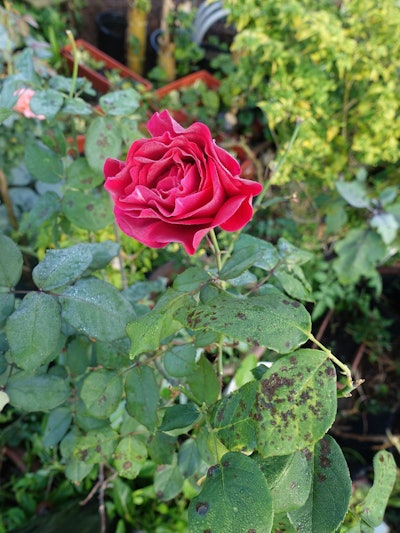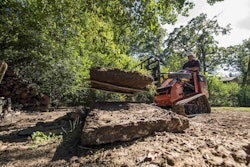 Photo: Scot Nelson/Flickr
Photo: Scot Nelson/FlickrIf your client is noticing black spots on their beloved roses, it is best to take note as this is likely a sign of a black spot infection.
One of the most common diseases roses are faced with is black spot, which can lead to severe defoliation. Like many diseases, it won’t kill the plant outright but it will weaken it to other diseases, insect attacks, and winter injury until it dies.
Where does it come from?
Black spot is caused by the fungus Diplocarpon rosae that commonly appears on hybrid teas, grandifloras, and miniature varieties of roses. The disease overwinters in diseased canes and infected leaves from the previous season and the spores spread to a new plant’s lower leaves by splashes from rain or irrigation.
The fungus can tolerate a range of temperatures so symptoms can develop all season long if the moisture is adequate. The leaves generally need to be wet for six to nine hours for fungus to develop.
What are the symptoms?
Infected roses display black spots up to 1/2 inch in diameter on the upper leaf surface and they occasionally have yellow halos surrounding them. Infected leaves eventually turn yellow and fall prematurely. Canes that are infected have raised, purple-red blotches that may later become blackened and blister.
Roses will become stunted and produce fewer, paler blooms. To tell it apart from other types of leaf spot look for the fringed margin and consistently black color.
What can I do?
For roses that have already been infected by black spot, first remove the infected leaves and stems on the rose and then also rake up any fallen leaves under the plant. These infected leaves should be thrown away or burned, not added to a compost pile.
You can then apply a fungicide treatment of chlorothalonil, mancozeb, myclobutanil, propiconazole, copper, or sulfur-containing products, which have been listed as successful at controlling the fungus, but the sprays will need to be applied every 7 to 14 days over the course of the summer to prevent infections. The applications can be less frequent if there is a dry spell.
Are there ways to prevent it?
It is always better to be proactive than reactive, and there are several cultural practices that can reduce the likelihood of black spot being an issue for your client’s roses. Maintaining good sanitation by cleaning out all the old leaves on the ground during the fall or winter will keep the plant away from any spores that are overwintering on infected leaves.
Another good practice is to water in the morning as this allows the moisture to evaporate from the leaves. Avoid getting the foliage wet, especially during warm humid weather. Soaker hoses are a good way to avoid overhead irrigation. Space roses at least 3 to 4 feet apart as this increases airflow. Also, placing the roses in sunny spots will help keep the moisture off.
Aside from this, there are also specific cultivars that have high levels of black spot resistance. The Knock Rose series, the Flower Carpet roses, Drift roses, and Meilland hybrids are all examples of roses that have resistance to the disease.










